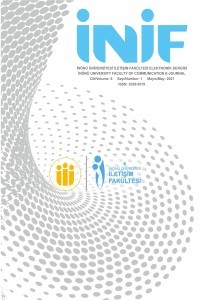HALKLA İLİŞKİLER VE REKLAMCILIK EĞİTİMİNDE SANAL GERÇEKLİK UYGULAMASI KULLANIMI ÜZERİNE BİR DEĞERLENDİRME
Sanal Gerçeklik, Eğitimde Sanal Gerçeklik, Yüksek Öğretim, Öğretim Tasarımı
AN EVALUATION ON THE USE OF VIRTUAL REALITY ADMINISTRATION IN PUBLIC RELATIONS AND ADVERTISING EDUCATION
___
- BARBOUR, Rosaline ve KITZINGER, Jenny. (Eds.). (2001). Developing Focus Group Research: Politics. Theory, and Practice, London: Sage.
- BAYRAKTAR, Erkan ve KALELİ, Fatih (2007). “Sanal Gerçeklik ve Uygulama Alanları” Akademik Bilişim. s. 1-6.
- BAYRAM, Servet. (1999). “Eğitimde sanal gerçeklik uygulamaları” M.Ü. Atatürk Eğitim Fakültesi Eğitim Bilimleri Dergisi, 11, s. 49-54.
- BOWLING, Ann. (2002). Research Methods in Health: Investigating Health and Health Services, Philadelphia: McGraw-Hill House.
- BRILL, L. (1994). "Metaphors For the Travelling Cybernaut--Part II". Virtual Reality World, (May/June), s. 30-33.
- BRİTTEN, Nicky. (1995). “Qualitative Interviews in Medical Research” British Medical Journal, 311.6999, s. 251–253.
- BYERS, Peggy Yuhas and WILCOX, James R. (1988). “Focus groups: an alternative method of gathering qualitative data in communication research”, Annual Meeting of the Speech Communication Association, 74th, New Orleans, LA, November 3–6, 1988.
- CHEN, Chih Hung, Yang, J. C., Shen, S., ve Jeng, M. C. (2007). “A Desktop Virtual Reality Earth Motion System in Astronomy Education” Educational Technology & Society, 10 (3), s.289-304.
- ÇAVAŞ, Bülent, HUYUGÜZEL ÇAVAŞ, Pınar ve TAŞKIN CAN, Bilge. (2004). “Eğitimde Sanal Gerçeklik” The Turkish Online Journal of Educational Technology, 3 (4), s.110-116.
- ÇOKLUK, Ömay, YILMAZ, Kürsad ve OĞUZ, Ebru. (2011). “Nitel Bir Görüşme Yöntemi: Odak Grup Görüşmesi” Kuramsal Eğitbilim Dergisi, 4 (1), s.95-107.
- DALE, Edgar. (1969). Audiovisiual Methods in Teaching, NY: Dryden Press.
- EDMUNDS, Holly. (2000). The Focus Group Research Handbook. New York: McGraw-Hill.
- ELLIS, Stephen R. (1994). “What are Virtual Environments?” IEEE Computer Graphics & Applications, 5 (4), s.17-21.
- ERYALÇIN, Babür. (1994). “Hayalle Gerçeğin Dansı Sanal Gerçeklik”, Bilim ve Teknik, 27 (323), s.20-27.
- FERN, Edward F. (2001). Advanced Focus Group Research. California: SAGE.
- FURNESS, T., WINN, William ve YU, Rose. (1997). “The İmpact Of Three Dimensional Immersive On Modern Pedagogy: Global Change, VR and Learning”, Proceedings of Workshops in Seattle, Washington, and Loughborough, England in May and June. 1997.
- GIBBS, Anita. (1997). “Focus Groups”, Social Research Update, 19., http://sru.soc.surrey.ac.uk/SRU19.html. Erişim Tarihi: 28.05.2017.
- GİZİR, Sıdıka. (2007). “Focus Groups İn Educational Studies”. Mersin Üniversitesi Eğitim Fakültesi Dergisi, 3 (1), s. 1–20.
- GREENBAUM, Paul. (1992). “The Lawnmower Man”, Film and Video, 9 (3), s. 58-62.
- KENNEY, Patrick J. and SAITO, Tim. (1994). “Results Of A Survey On The Use Of A Virtual Environment Technology İn Training NASA Flight Controllers For The Hubble Space Telescope Servicing Mission (Contract No. NAS 9- 18630)”, Huston, TX: National Acronautics and Space Administration.
- KIM, Jong-Heon, PARK, S. T., LEE, H., YUK, K. C., and LEE, H. (2001). “Virtual Reality Simulations İn Physics Education”, Interactive Multimedia Electronic Journal of Computer-Enhanced Learning, 3 (2).
- KITZINGER, Jenny. (1995). “Qualitative Research: Introducing Focus Groups”, British Medical Journal, 311, s. 299–302.
- KRUEGER, Richard A. (1994). Focus Groups: A Practical Guide For Applied Research, London: SAGE.
- LARIJANI, Casey C. (1994). The Virtual Reality Primer. New York: McGraw‐Hill.
- LAVE, Jane, and WENGER, Etienne. (1991). Situated Learning: Legitimate Peripheral Practice, Cambridge: Cambridge University Press.
- MAYS, Nicholas ve POPE, Catherine. (1995). “Rigour and qualitative research”, British Medical Journal, 311, s. 109–112.
- MCBRIEN, Shawn, FELIZARDO, G.R., ORR, D.G. and RAYMOND, M.J. (2008). “Using Focus Groups To Revise An Educational Booklet For People Living With Methicillin-Resistant”, Health Promotion Practice, 9 (1), s. 19–28.
- MCGONIGLE, Dee ve EGGERS, Renee M. (1998). “Stages of Virtuality: Instructor and Student. The Association for Educational Communication and Technology”, TechTrends: For Leaders in Education and Training, Vol.43 (3), s. 23-26.
- MCLELLAN, Hilary (1992). Virtual reality: A selectbibliography. Englewood Cliffs, NJ: Educational Technology Publications.
- NANCARROW, Clive, VIR, Jason ve BARKER, Andy. (2005). “Ritzer´S Mcdonaldisation and Applied Qualitative Marketing Research”, Qualitative Market Research: An International Journal, 8 (3), s. 296–311.
- STEUER, Jonathan. (1993). “Defining Virtual Reality: Dimensions Determining Telepresence”, Journal of Communication, 4 (2), s. 73-93.
- STEWART, Dawid W. ve SHAMDASANI, Prem N. (1990). Focus Groups: Theory and Practice. Newbury Park, CA: SAGE.
- STUART, Rory ve THOMAS, John C. (1991). “The Implications of Education in Cyberspace”, Multimedia Review, 2, s. 17–27.
- TAPSCOTT, Don. (2009). Grown Up Digital. How The Net Generation Is Changing The World. New York: McGraw-Hill.
- ZICHERMANN, Gabe ve LINDER, Joselin. (2010). Game-Based Marketing. Inspire Customer Loyalty Through Rewards, Challenges, And Contests. N.J: Hoboken.
- http://imej.wfu.edu/articles/2001/2/02/ Erişim Tarihi: 22.05.2017.
- http://www.hypergridbusiness.com/2016/09/engage-vr-targets-educators-businesses-with-free-platform-and-content-creation/ Erişim tarihi: 23.05.2017.
- https://arstechnica.com/gaming/2016/10/best-vr-headset-2016-psvr-rift-vive/ Erişim tarihi: 23.05.2017.
- Yayın Aralığı: Yılda 2 Sayı
- Başlangıç: 2016
- Yayıncı: İnönü Üniversitesi
Halil İbrahim GÜRCAN, Engin COŞKUN, Necip Serdar SEVER, Emrah BAŞER, Murat ATAİZİ, Mesude Canan ÖZTÜRK, Adil BİCAL
BİR KİTLE İLETİŞİM ARACI OLARAK TELEVİZYONUN SİNEMADA TEMSİLİ
MEDYA-SİYASET VE İDEOLOJİ İLİŞKİSİ BAĞLAMINDA TÜRKİYE’DE KÖŞE VE HABER YAZIMI
DÜNYA SİNEMASINDA GÖRSEL EFEKTİN GELİŞİMİ: TÜRK SİNEMASINDAKİ UYGULAMALARI
PARA-SOSYAL İLİŞKİ TEORİSİ PERSPEKTİFİNDEN ÜRÜN YERLEŞTİRME ETKİLİLİĞİ
1980’Lİ YILLARDAN GÜNÜMÜZE TÜRK YAZILI BASININDA ÇOCUK OLGUSU
